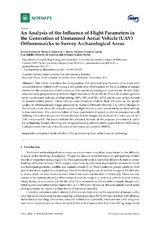An Analysis of the Influence of Flight Parameters in the Generation of Unmanned Aerial Vehicle (UAV) Orthomosaicks to Survey Archaeological Areas
Autor
Mesas Carrascosa, Francisco Javier
Notario García, María Dolores
Meroño de Larriva, José Emilio
García-Ferrer Porras, Alfonso
Editor
MDPIFecha
2016Materia
Unmanned aerial vehicle (UAV)Positional quality
Orthomosaick
Archeology
METS:
Mostrar el registro METSPREMIS:
Mostrar el registro PREMISMetadatos
Mostrar el registro completo del ítemResumen
This article describes the configuration and technical specifications of a multi-rotor
unmanned aerial vehicle (UAV) using a red–green–blue (RGB) sensor for the acquisition of images
needed for the production of orthomosaics to be used in archaeological applications. Several flight
missions were programmed as follows: flight altitudes at 30, 40, 50, 60, 70 and 80 m above ground
level; two forward and side overlap settings (80%–50% and 70%–40%); and the use, or lack thereof,
of ground control points. These settings were chosen to analyze their influence on the spatial
quality of orthomosaicked images processed by Inpho UASMaster (Trimble, CA, USA). Changes in
illumination over the study area, its impact on flight duration, and how it relates to these settings
is also considered. The combined effect of these parameters on spatial quality is presented as well,
defining a ratio between ground sample distance of UAV images and expected root mean square of a
UAV orthomosaick. The results indicate that a balance between all the proposed parameters is useful
for optimizing mission planning and image processing, altitude above ground level (AGL) being
main parameter because of its influence on root mean square error (RMSE).

